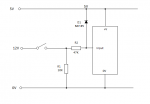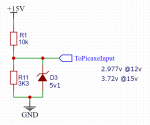I'm planning a monitor/alarm module for a diesel engine with nominal 12V alternator and lead-acid battery. Some digital inputs to a 14M2 will be at the alternator/battery voltage which could conceivably be between 10 or 11 and 15V.
Is this from post 4 in this thread be the sort of circuit that is best suited to deal with this sort of voltage?

Is this from post 4 in this thread be the sort of circuit that is best suited to deal with this sort of voltage?



